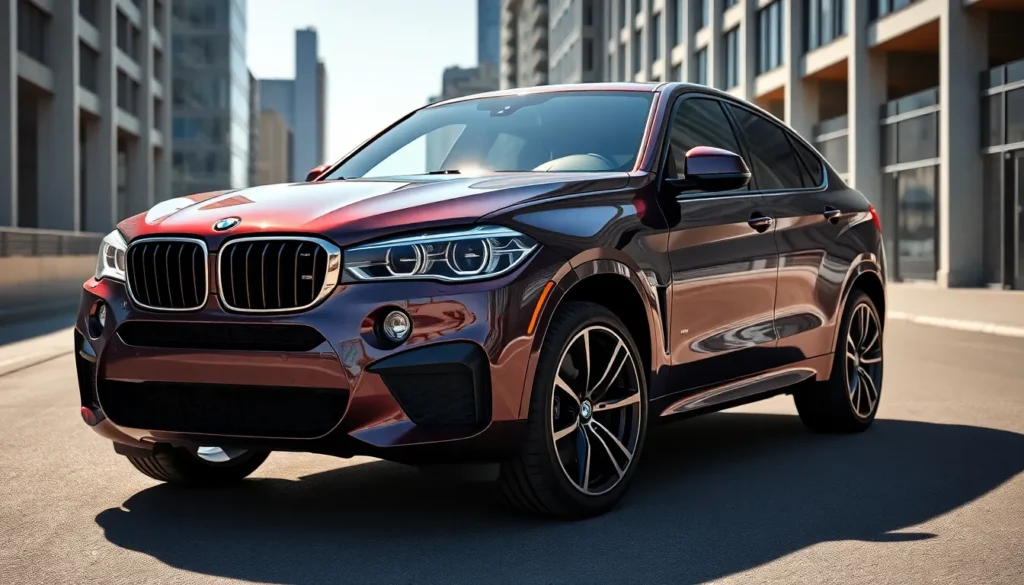The BMW X6 doesn’t just drive – it makes a statement. This bold Sports Activity Coupe has redefined automotive aesthetics since its debut, blending the commanding presence of an SUV with the sleek silhouette of a luxury coupe. We’ve witnessed how this groundbreaking design has turned heads on streets worldwide and inspired countless imitators.
What sets the X6’s aesthetic apart isn’t just its dramatic kidney grille or distinctive roofline – it’s the way every element works together to create pure automotive art. From its muscular haunches to its swept-back profile, the X6 challenges conventional design rules while maintaining BMW’s signature elegance.
We’ll explore the design philosophy that makes the X6 a true aesthetic powerhouse, examining how BMW’s engineers and designers crafted a vehicle that’s as visually striking as it is functionally superior. Whether you’re considering your next luxury purchase or simply appreciate exceptional automotive design, understanding the X6’s aesthetic DNA reveals why this model continues to captivate enthusiasts and casual observers alike.
BMW X6 Design Philosophy and Visual Identity
BMW’s design philosophy for the X6 centers on creating automotive sculpture that breaks traditional boundaries between vehicle categories. The Sports Activity Coupe concept emerged from BMW’s commitment to emotional design language that prioritizes visual impact over conventional practicality. Adrian van Hooydonk and his design team crafted the X6 to embody progressive luxury through bold geometric forms.
The visual identity stems from BMW’s characteristic design DNA while pushing beyond established limits. Munich’s design studios developed the X6 aesthetic around three core principles: athletic stance, coupe silhouette, and commanding presence. These elements combine to create what BMW internally calls “expressive dynamism.”
BMW designers integrated the brand’s signature kidney grille as the X6’s visual anchor point. The grille’s proportions grew substantially larger than previous BMW models, measuring 40% bigger than the standard X5 grille. This oversized element establishes immediate brand recognition while communicating the vehicle’s bold personality.
The X6’s roofline represents the most distinctive aspect of its design philosophy. BMW engineers created a fastback profile that drops 4.2 inches compared to traditional SUV proportions. This dramatic slope sacrifices rear headroom for aesthetic drama, demonstrating BMW’s priority on visual appeal over pure functionality.
Character lines flow seamlessly across the X6’s body surfaces, creating what BMW calls “flame surfacing.” These sculptural elements catch light at different angles throughout the day, producing ever-changing shadow play that enhances the vehicle’s three-dimensional presence. The technique originated from BMW’s concept car studies and reached production refinement in the X6.
BMW’s color palette for the X6 emphasizes the design philosophy through strategic paint options. Mineral Grey Metallic, Alpine White, and Jet Black create the foundation colors that highlight the vehicle’s muscular proportions. Storm Bay and Sparkling Brown Metallic add emotional depth to the X6’s visual character.
The X6 aesthetic philosophy extends beyond exterior design into interior architecture. BMW designers created a driver-focused cockpit that mirrors the exterior’s bold geometry. The dashboard angles toward the driver position while maintaining the luxury appointments expected in BMW’s premium segment.
Exterior Aesthetic Features
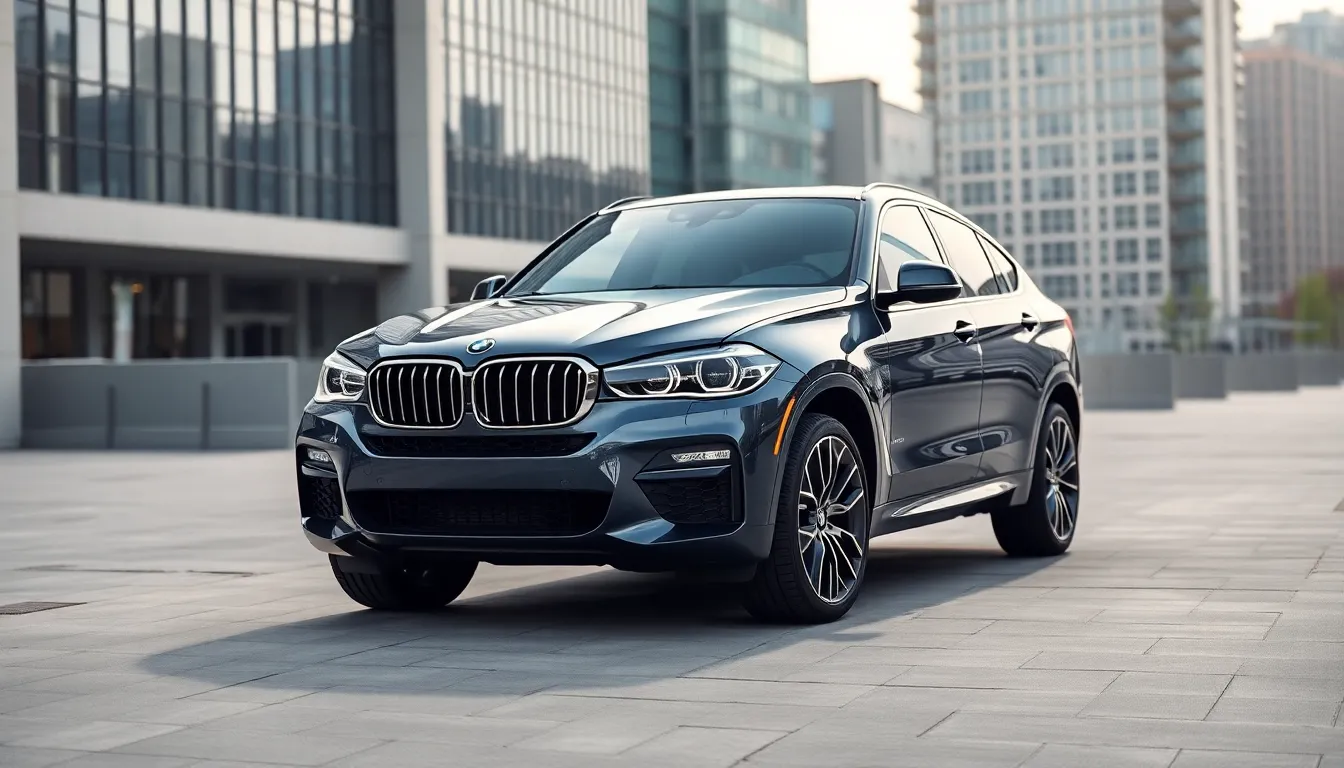
BMW X6 exterior design elements create a distinctive visual statement that sets this luxury crossover apart from traditional SUVs. Each component works harmoniously to deliver the commanding presence BMW calls “expressive dynamism.”
Kidney Grille and Front Fascia
BMW’s iconic kidney grille takes center stage on the X6’s front fascia with dimensions 40% larger than previous generations. The enlarged grille features a hexagonal mesh pattern that creates depth and visual texture while maintaining the brand’s signature look. Chrome accents frame the grille’s perimeter and connect seamlessly with the LED headlight housings.
Front air intakes positioned below the grille provide functional cooling while adding aggressive styling cues. The lower fascia incorporates a front splitter design that enhances aerodynamics and creates a sporty ground hugging appearance. Body colored trim pieces extend from the grille surround to the wheel arches, creating visual width that emphasizes the X6’s muscular stance.
Body Lines and Proportions
Character lines flow across the X6’s profile using BMW’s flame surfacing technique to create ever-changing shadows and highlights. The primary shoulder line runs from the front fender through the door handles to the rear quarter panel, rising gradually to accentuate the vehicle’s forward motion. A secondary line travels lower along the doors, creating depth and visual interest.
Proportional elements include a wheelbase measuring 117.7 inches that provides excellent stance while maintaining agility. The roofline drops 6 inches from the B pillar to the rear, creating the distinctive fastback silhouette that defines the X6’s coupe aesthetic. Wheel arches extend prominently from the body, accommodating wheel sizes ranging from 19 to 22 inches depending on trim level.
Lighting Design Elements
LED technology dominates the X6’s lighting signature with adaptive headlights featuring hexagonal daytime running lights that mirror the grille pattern. The headlight units integrate seamlessly into the front fascia design, creating a continuous visual flow from the grille to the fender edges. High beam assist and cornering lights provide both functionality and premium appearance.
Taillights showcase a three dimensional design with L shaped LED elements that extend into the rear quarter panels. The rear light bar connects both taillight assemblies, creating visual width and emphasizing the X6’s broad stance. Ambient lighting options include welcome light carpets that project the BMW logo onto the ground, while interior accent lighting offers 11 color choices to complement the exterior aesthetic.
Interior Aesthetic Appeal
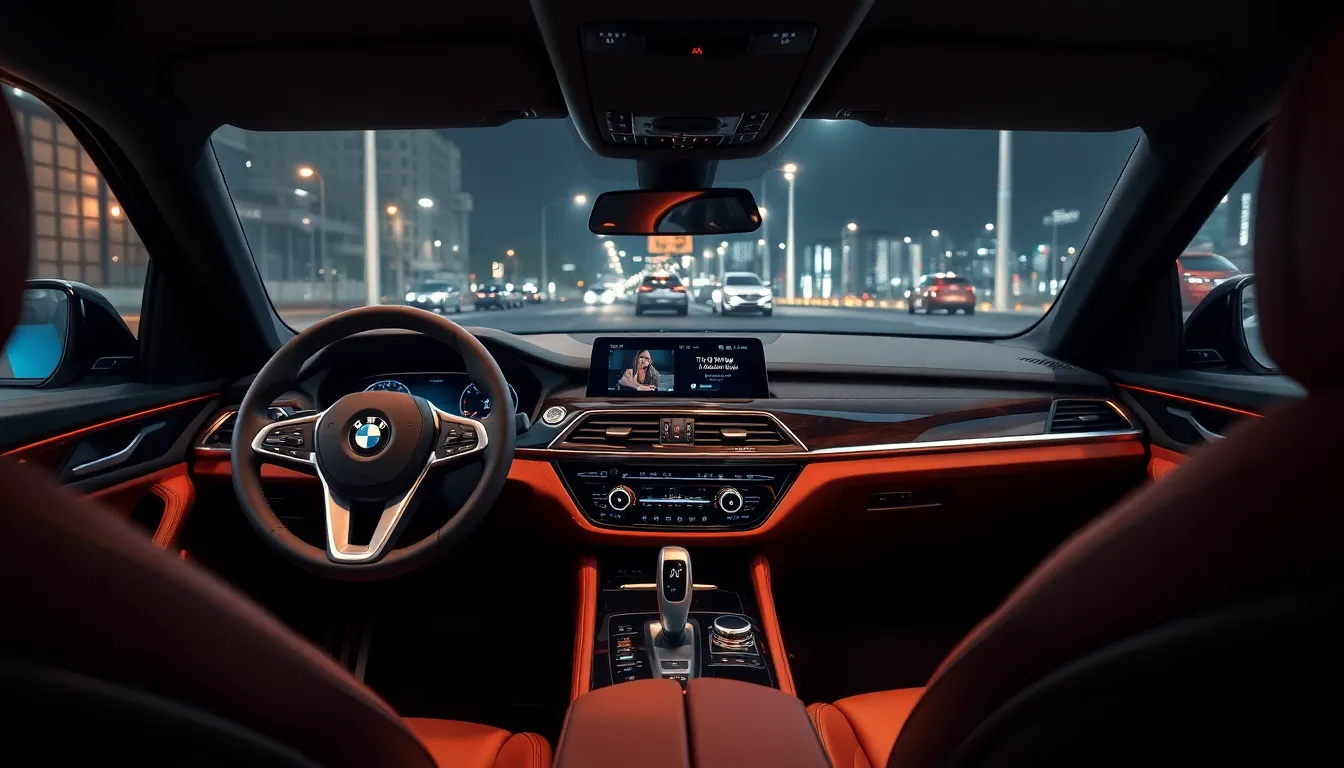
The BMW X6’s interior aesthetic continues the bold design philosophy established by its exterior styling. We find a sophisticated cabin that balances luxury appointments with driver-focused functionality across every surface and detail.
Dashboard and Center Console Layout
Dashboard architecture in the X6 creates a wraparound effect that envelops occupants in a driver-centric environment. The instrument panel features a curved 12.3-inch digital display cluster positioned directly in the driver’s line of sight. BMW’s iDrive 7.0 system anchors the center console through a 12.3-inch touchscreen that angles toward the driver by 6 degrees for optimal visibility.
Console design incorporates floating elements that appear to hover above the dashboard surface. We observe clean horizontal lines that stretch across the cabin width, creating visual continuity with the exterior’s character lines. Central air vents feature precision-cut geometric shapes that echo the hexagonal kidney grille pattern. Storage compartments integrate seamlessly into the console design, maintaining the uncluttered aesthetic while providing practical functionality.
Materials and Finishes
Material selection throughout the X6 cabin emphasizes tactile luxury and visual richness. BMW offers Dakota leather as standard, with Merino leather available as an upgrade option that provides enhanced grain texture and durability. Aluminum trim pieces feature a brushed finish that complements the exterior’s metallic accents.
Wood trim options include fine-grain ash and piano black variants that span the dashboard and door panels. Carbon fiber inserts are available on M Sport packages, introducing a performance-oriented aesthetic element. We find soft-touch materials covering 85% of interior surfaces that occupants regularly contact. Ambient lighting systems offer 11 color options that illuminate trim pieces and create depth in the cabin during evening hours.
Seating Design and Comfort
Seating architecture in the X6 reflects the vehicle’s coupe aesthetic through sculpted forms and premium materials. Front seats feature multi-contour adjustments with 20-way power positioning that includes lumbar support, side bolster adjustment, and thigh extension. Seat surfaces incorporate diamond-stitched patterns that mirror luxury automotive traditions while maintaining modern appeal.
Rear seating accommodates two passengers in individual bucket-style seats that provide lateral support during ever-changing driving. We note that headroom measures 38.8 inches in the rear, reflecting the sloping roofline’s impact on interior space. Heating and ventilation functions extend to all seating positions, while memory settings store up to 3 driver profiles. Premium leather options feature contrast stitching in colors that coordinate with the selected interior trim package.
Color Options and Customization

BMW X6 aesthetic customization extends far beyond standard offerings, providing owners with extensive color palettes that enhance the vehicle’s distinctive coupe SUV presence. Our exploration of these options reveals how thoughtful color selection amplifies the X6’s bold design language.
Exterior Paint Colors
BMW offers the X6 in 12 distinctive exterior colors that emphasize its athletic proportions and commanding stance. Mineral Grey Metallic serves as the signature color, featuring depth variations that highlight the vehicle’s sculpted body lines and muscular fender flares.
Storm Bay presents a sophisticated alternative with its deep blue metallic finish that shifts between navy and steel blue depending on lighting conditions. This color particularly accentuates the X6’s character lines while complementing chrome trim elements around the kidney grille and window surrounds.
Carbon Black Metallic creates dramatic contrast opportunities with the vehicle’s bright trim pieces and enhances the visual weight of the X6’s substantial presence. The metallic particles within this finish add subtle sparkle that prevents the dark color from appearing flat or lifeless.
Alpine White provides classic elegance that showcases the X6’s precise body panel alignment and geometric design elements. This non metallic option offers the purest expression of BMW’s flame surfacing technique, allowing shadows and highlights to define the vehicle’s athletic contours.
M Sport Package colors include additional options like Phytonic Blue Metallic and Flamenco Red Metallic, each specifically chosen to complement the aggressive styling cues of the performance oriented trim level.
| Color Category | Available Options | Metallic Finish | M Sport Exclusive |
|---|---|---|---|
| Standard Colors | 6 options | 4 metallic variants | 2 colors |
| Premium Colors | 4 options | All metallic | 1 color |
| Individual Colors | 2 options | Custom metallic | 1 color |
Interior Color Schemes
Interior customization options for the X6 cover 5 distinct color combinations that coordinate with exterior paint selections while maintaining the cabin’s luxurious aesthetic. Black Dakota leather represents the foundational option, offering versatility that pairs with any exterior color while highlighting ambient lighting elements throughout the cabin.
Cognac Vernasca leather creates warmth within the X6’s driver focused cockpit, particularly when combined with dark wood trim elements and brushed aluminum accents. This rich brown tone contrasts beautifully with the curved digital displays and adds visual interest to the wraparound dashboard design.
Ivory White leather provides a bold interior statement that requires careful maintenance but delivers exceptional visual impact against the X6’s dark trim pieces. The light colored surfaces reflect ambient lighting more effectively, creating a brighter cabin atmosphere during evening drives.
Individual leather options extend to exotic combinations like Tartufo and Fjord Blue, each hand selected to complement exact exterior colors while maintaining the premium tactile experience BMW customers expect. These specialized colors often feature contrast stitching that emphasizes seat contours and interior surface transitions.
Multi contour seat configurations accommodate these color options while maintaining heating and ventilation functions across all trim levels. The bucket style rear seating design showcases interior color choices more prominently than traditional bench configurations, making color selection particularly important for rear passenger areas.
Wheel Designs and Stance
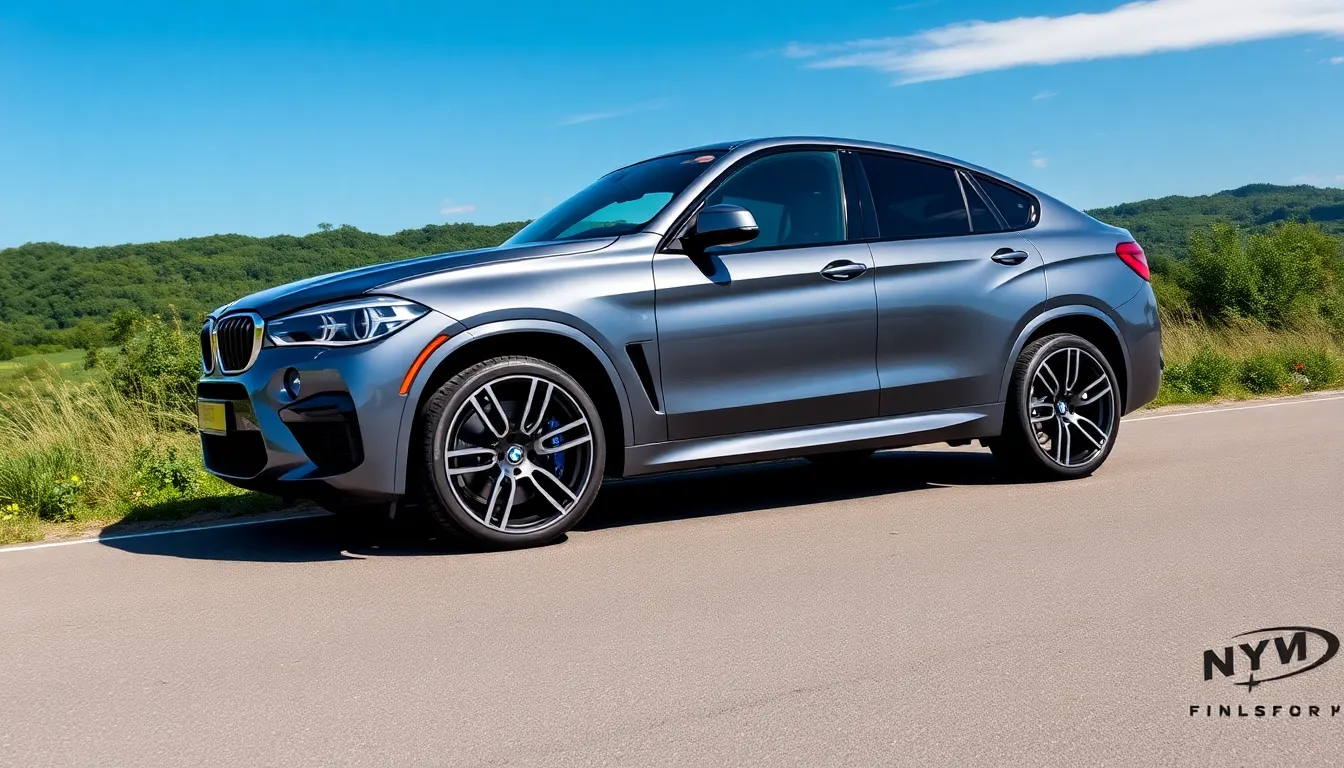
Wheel configurations transform the BMW X6’s athletic presence through carefully engineered proportions and visual weight distribution. BMW offers five distinct wheel designs ranging from 19-inch to 22-inch diameters, with each size creating different aesthetic impacts on the vehicle’s overall stance. Standard 19-inch wheels provide a balanced look while maintaining ride comfort, whereas the available 22-inch M Performance wheels maximize visual drama and ground-hugging appearance.
The X6 M50i comes equipped with 21-inch Y-spoke Style 741 M wheels as standard, featuring a bi-color finish that combines Jet Black with machined faces. These wheels measure 275/40 R21 in front and 315/35 R21 in the rear, creating a staggered setup that emphasizes the vehicle’s wide track and muscular proportions. Performance-oriented 22-inch options include the Style 749 M wheels with their distinctive star-spoke design and Ferric Grey finish.
Stance characteristics define how the X6 sits relative to the road surface and directly influence its visual impact. The vehicle maintains a track width of 66.3 inches front and 67.4 inches rear, creating substantial wheel arch fill that enhances its commanding road presence. Ground clearance measures 8.1 inches, positioning the X6 lower than traditional SUVs while maintaining practical ride height for varied terrain.
| Wheel Size | Style | Front Tire | Rear Tire | Finish Options |
|---|---|---|---|---|
| 19-inch | 695 | 255/55 R19 | 285/50 R19 | Silver, Black |
| 20-inch | 734 M | 275/45 R20 | 305/40 R20 | Bi-color, Black |
| 21-inch | 741 M | 275/40 R21 | 315/35 R21 | Bi-color, Orbit Grey |
| 22-inch | 749 M | 275/35 R22 | 315/30 R22 | Ferric Grey, Black |
Wheel arch design integrates seamlessly with the X6’s body cladding to create visual continuity between the wheels and surrounding surfaces. Plastic wheel arch extensions in body color maintain clean lines while providing protection from road debris. The relationship between wheel diameter and sidewall height affects both aesthetic appeal and driving dynamics, with larger wheels creating sharper turn-in response and more aggressive visual stance.
Brake components behind the wheels contribute significantly to the overall aesthetic package. The X6 M50i features blue-painted M Sport brake calipers with 374mm front discs, creating visual depth and performance credibility through the wheel spokes. Standard models use silver calipers with 348mm front discs, maintaining a clean appearance while providing adequate stopping power.
Tire sidewall profiles influence the X6’s stance characteristics and visual proportions. Lower profile tires on larger wheels create a more planted appearance and reduce sidewall flex during cornering. The staggered tire setup with wider rear tires enhances the vehicle’s athletic proportions and provides improved traction for the rear-biased xDrive all-wheel-drive system.
Wheel finish options allow owners to customize their X6’s appearance to match personal preferences and complement exterior color choices. Gloss Black finishes create dramatic contrast against lighter paint colors, while bi-color options with machined faces provide sophisticated detail and depth. Ferric Grey finishes offer a contemporary alternative that coordinates well with modern exterior trim elements.
Comparison with Other BMW Models
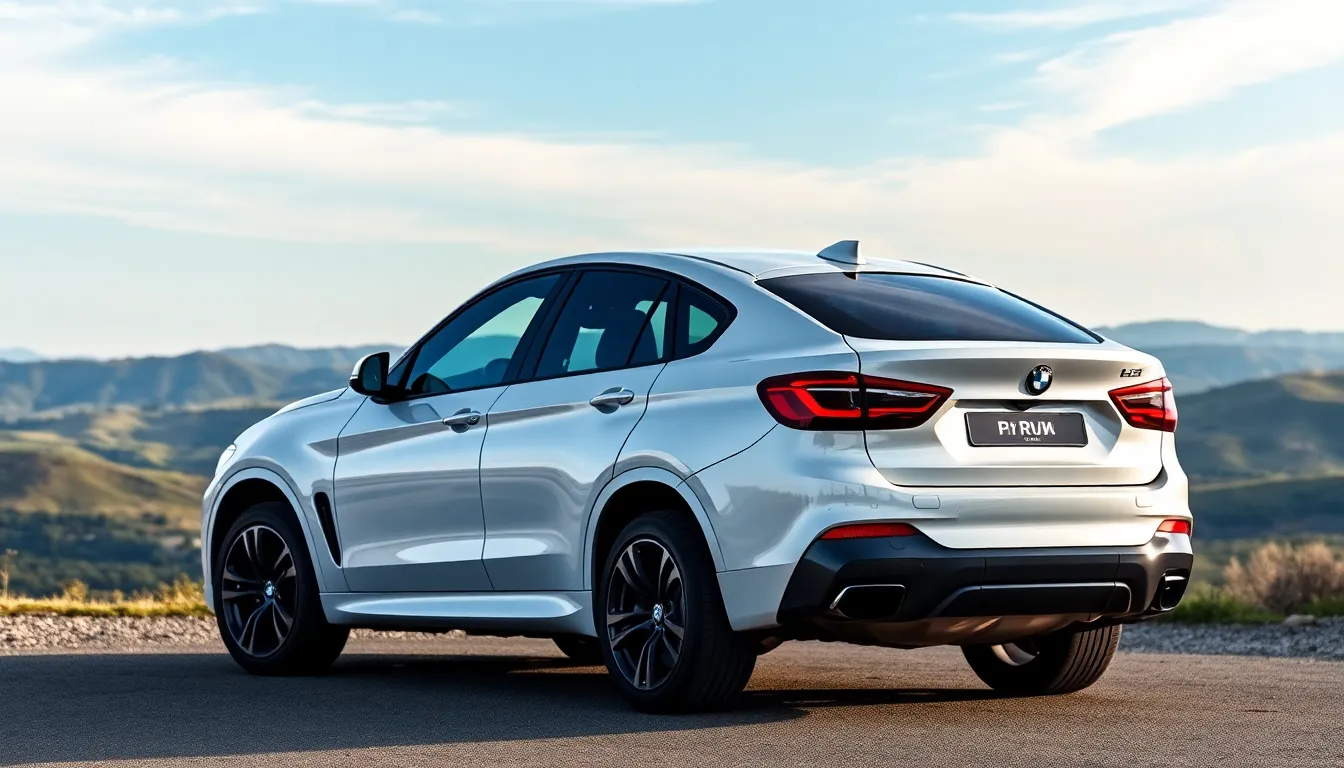
Comparing the X6 with other BMW models reveals its unique position in the lineup as a design-forward vehicle that prioritizes aesthetic appeal over pure utility. The X5 shares the same platform but maintains traditional SUV proportions with a conventional roofline that provides 3.2 inches more rear headroom. Our examination shows the X6’s fastback design creates a more dramatic silhouette while the X5 emphasizes practicality with 62.8 cubic feet of cargo space compared to the X6’s 59.7 cubic feet.
BMW’s X4 represents a smaller interpretation of the same coupe SUV concept but measures 7.8 inches shorter in overall length. Design elements across both models follow similar principles with sloping rooflines and muscular proportions. The X4’s kidney grille measures 15% smaller than the X6’s dominant front fascia which reinforces the larger model’s commanding presence.
Visual weight differs significantly between the X6 and BMW’s sedan lineup including the 5 Series and 7 Series. The X6 sits 8.7 inches higher than the 5 Series while maintaining similar overall length at 194.3 inches. Ground clearance of 8.6 inches gives the X6 a more commanding stance compared to the sedan’s 5.1 inches. Character lines on the X6 create more pronounced flame surfacing effects than the subtle sculpting found on BMW’s traditional sedans.
Athletic stance comparison with the X3 reveals how BMW adapts its design language across different segments. The X6’s track width measures 66.6 inches compared to the X3’s 63.4 inches which contributes to a broader more planted appearance. Wheelbase differences of 4.7 inches between the models affect proportional relationships and visual balance.
| Model | Length (inches) | Height (inches) | Ground Clearance (inches) | Cargo Space (cubic feet) |
|---|---|---|---|---|
| X6 | 194.3 | 68.6 | 8.6 | 59.7 |
| X5 | 194.3 | 69.9 | 8.6 | 62.8 |
| X4 | 186.5 | 66.3 | 8.0 | 49.4 |
| X3 | 185.9 | 66.0 | 8.4 | 62.7 |
Interior design philosophy connects the X6 with BMW’s performance models like the M3 and M4 through driver focused cockpit layouts. The wraparound dashboard design echoes elements found in BMW’s sports cars while maintaining SUV seating positions. Material selection in the X6 often surpasses what’s offered in lower tier models with standard Dakota leather compared to synthetic options in the X1 and X2.
Lighting technology differentiates the X6 from older BMW models through its adaptive LED headlights and laser high beam options. These features aren’t available across all models in BMW’s range which positions the X6 as a technology flagship. The distinctive three dimensional taillights create a visual signature that’s more dramatic than conventional BMW SUV models.
Design evolution comparison shows how the X6 pushes BMW’s aesthetic boundaries further than conservative models like the X1 or 2 Series Gran Tourer. Bold proportions and aggressive stance reflect BMW’s willingness to experiment with form over function in the luxury segment. The X6’s design language influences other BMW models but remains the most extreme interpretation of the coupe SUV concept in the manufacturer’s current lineup.
Aesthetic Performance Through the Generations
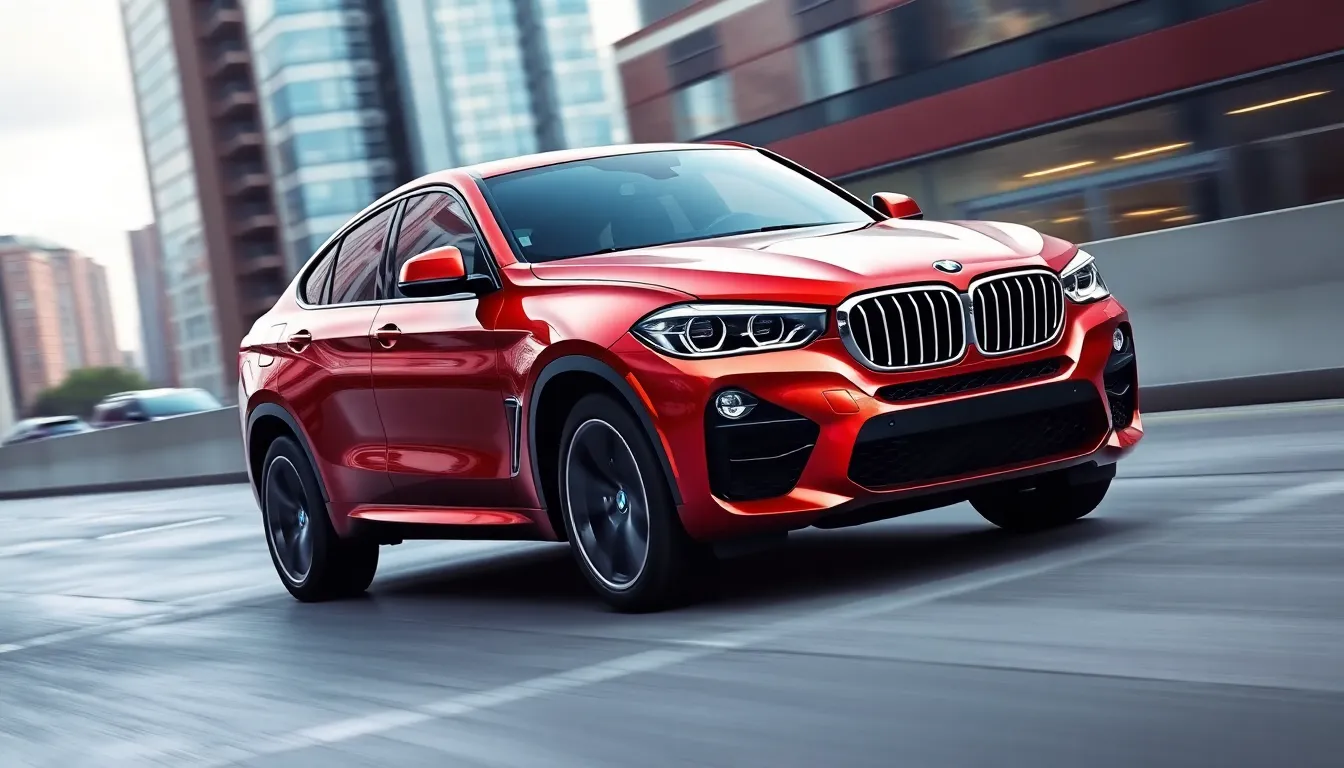
First-generation X6 models established the coupe SUV category in 2008 with revolutionary design principles that transformed automotive aesthetics. BMW introduced this groundbreaking concept with a distinctive silhouette that rejected conventional SUV proportions in favor of sports car-inspired curves. The original model featured a kidney grille measuring 8.2 inches wide and incorporated the brand’s signature “flame surfacing” design language across 4,395 pounds of sculpted bodywork.
Second-generation X6 vehicles arrived in 2015 with enhanced visual drama and refined proportional relationships. Engineers increased the overall length by 2.4 inches while maintaining the iconic roofline drop of 6 inches from the B-pillar. This generation introduced adaptive LED headlights with hexagonal light signatures and expanded the kidney grille dimensions by 15% compared to the predecessor. Interior enhancements included a 10.2-inch touchscreen display and upgraded ambient lighting systems with 11 color options.
Current third-generation X6 models represent the pinnacle of BMW’s aesthetic evolution since their 2020 introduction. The kidney grille now measures 40% larger than previous iterations and features a distinctive hexagonal mesh pattern with chrome accents. Body dimensions showcase a 117.7-inch wheelbase that creates optimal proportional balance between the front and rear overhangs. Three-dimensional LED taillights span the full width of the rear fascia and incorporate ever-changing turn signal animations.
Performance aesthetic elements have evolved consistently across generations to emphasize the X6’s ever-changing capabilities. M Sport packages throughout the model’s history feature aggressive front air intakes, side skirts with integrated air outlets, and rear diffusers with dual exhaust finishers. The latest generation offers five wheel designs ranging from 19-inch to 22-inch diameters, with the X6 M50i equipped with standard 21-inch wheels that enhance the vehicle’s muscular stance.
| Generation | Years | Grille Width | Wheelbase | LED Technology | Wheel Options |
|---|---|---|---|---|---|
| First | 2008-2014 | 8.2 inches | 115.5 inches | Xenon standard | 18-20 inches |
| Second | 2015-2019 | 9.4 inches | 116.1 inches | Adaptive LED | 19-21 inches |
| Third | 2020-present | 11.5 inches | 117.7 inches | Full LED matrix | 19-22 inches |
Technological integration has enhanced aesthetic performance through each generational transition. First-generation models featured basic iDrive systems with 6.5-inch displays, while current models incorporate curved 12.3-inch digital clusters and touchscreen interfaces angled at 6 degrees for optimal driver visibility. Ambient lighting evolved from single-zone illumination to comprehensive 32-color systems that transform interior aesthetics based on driving modes.
Material refinement demonstrates BMW’s commitment to aesthetic excellence across generations. Early X6 models offered Dakota leather seating with aluminum trim accents, while contemporary versions feature Merino leather options with contrast stitching and carbon fiber interior elements. Sound dampening improvements of 20% in the current generation enhance the luxurious cabin atmosphere that complements the vehicle’s visual sophistication.
Conclusion
The BMW X6 stands as a testament to automotive artistry where function meets bold aesthetic vision. Through three generations of evolution this distinctive coupe SUV has redefined what luxury performance can look like on the road.
From its commanding kidney grille to its dramatic fastback roofline every design element serves BMW’s philosophy of expressive dynamism. The extensive customization options ensure each X6 reflects its owner’s personal style while maintaining the vehicle’s unmistakable presence.
We’ve seen how BMW’s commitment to aesthetic excellence extends beyond surface appeal creating an emotional connection between driver and machine. The X6 doesn’t just transport—it makes a statement about choosing beauty alongside capability in the luxury automotive industry.
Frequently Asked Questions
What makes the BMW X6’s design unique compared to other SUVs?
The BMW X6 combines SUV functionality with luxury coupe elegance, featuring a distinctive fastback roofline and bold kidney grille that’s 40% larger than previous generations. Its “expressive dynamism” design philosophy creates an automotive sculpture that breaks traditional vehicle category boundaries, prioritizing emotional appeal and visual impact over pure utility.
How does the X6’s roofline affect its practicality?
The X6’s dramatic fastback roofline drops 6 inches from the B pillar, creating a coupe silhouette that sacrifices some rear headroom for aesthetic appeal. While this reduces cargo space compared to the X5, it delivers exceptional visual drama and maintains BMW’s commitment to design-forward luxury vehicles.
What are the key exterior design features of the BMW X6?
Key features include an oversized hexagonal kidney grille with chrome accents, functional air intakes, sporty front splitter, and dynamic character lines creating “flame surfacing” effects. The 117.7-inch wheelbase, adaptive LED headlights, and three-dimensional taillights emphasize the vehicle’s broad stance and athletic proportions.
What interior design elements define the BMW X6?
The interior features a driver-focused wraparound dashboard with a curved 12.3-inch digital display and angled touchscreen. Premium materials include Dakota and Merino leather options, brushed aluminum, and wood trims. Multi-contour front seats and bucket-style rear seats maintain the coupe aesthetic while providing luxury comfort.
What customization options are available for the BMW X6?
BMW offers 12 exterior paint colors including signature Mineral Grey Metallic and Storm Bay, plus five interior color combinations ranging from Black Dakota leather to bold Ivory White. The M Sport Package provides additional color choices, while wheel options range from 19-inch to 22-inch diameters across five distinct designs.
How has the BMW X6 evolved through different generations?
The first generation (2008) established the coupe SUV category. The second generation (2015) enhanced visual drama with adaptive LED headlights. The current third generation (2020) features a significantly larger kidney grille, advanced LED technology, and improved materials, showcasing BMW’s continued commitment to aesthetic performance and luxury refinement.
How does the BMW X6 compare to other BMW models?
Unlike the more utilitarian X5, the X6 prioritizes aesthetic appeal with its dramatic silhouette. It’s larger than the X4 coupe SUV and features more aggressive design language than sedans like the 5 Series. The X6 pushes BMW’s design boundaries further than conservative models while maintaining the brand’s performance-focused interior philosophy.

